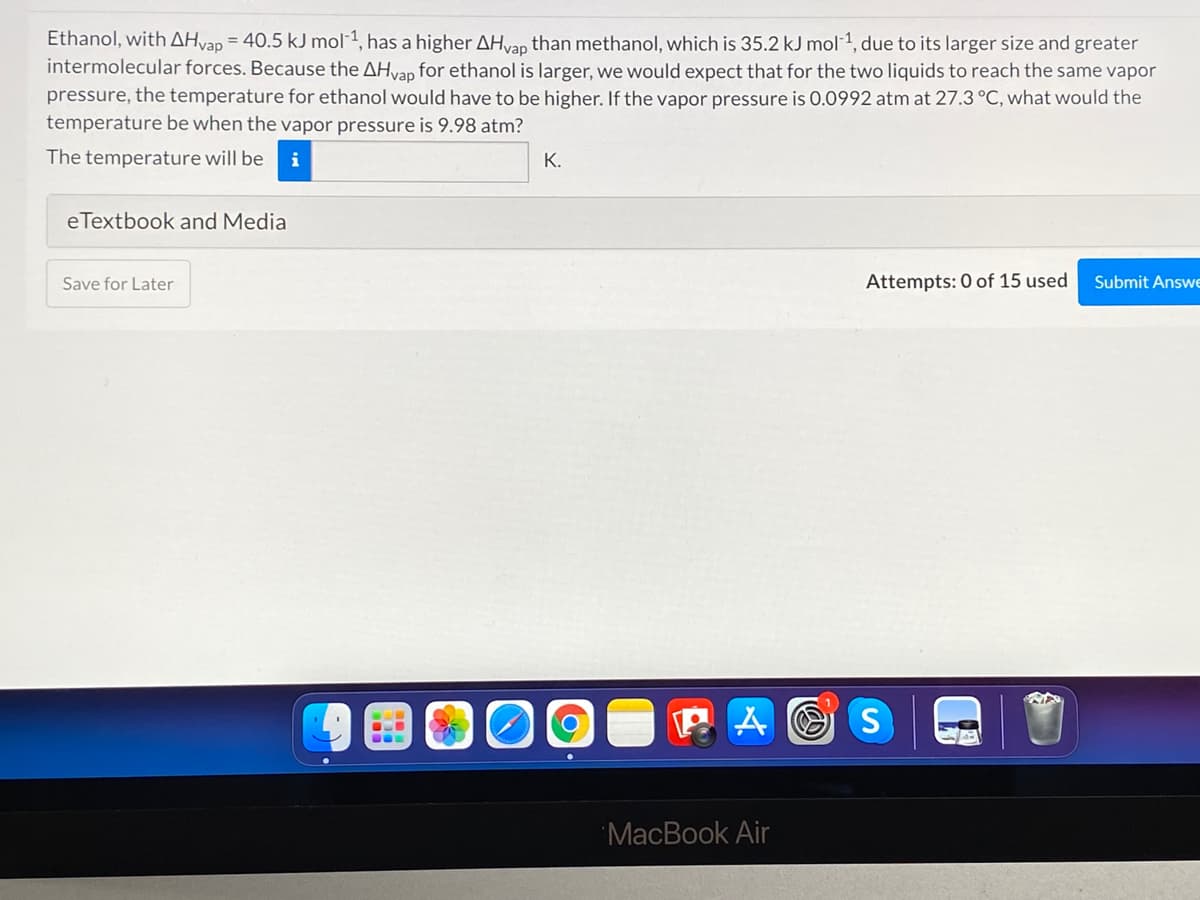Ethanol, with AHvap = 40.5 kJ mol1, has a higher AHvap than methanol, which is 35.2 kJ mol1, due to its larger size and greater intermolecular forces. Because the AHvap for ethanol is larger, we would expect that for the two liquids to reach the same vapor pressure, the temperature for ethanol would have to be higher. If the vapor pressure is 0.0992 atm at 27.3 °C, what would the temperature be when the vapor pressure is 9.98 atm? The temperature will be К.
Ethanol, with AHvap = 40.5 kJ mol1, has a higher AHvap than methanol, which is 35.2 kJ mol1, due to its larger size and greater intermolecular forces. Because the AHvap for ethanol is larger, we would expect that for the two liquids to reach the same vapor pressure, the temperature for ethanol would have to be higher. If the vapor pressure is 0.0992 atm at 27.3 °C, what would the temperature be when the vapor pressure is 9.98 atm? The temperature will be К.
Chemistry: An Atoms First Approach
2nd Edition
ISBN:9781305079243
Author:Steven S. Zumdahl, Susan A. Zumdahl
Publisher:Steven S. Zumdahl, Susan A. Zumdahl
Chapter9: Liquids And Solids
Section: Chapter Questions
Problem 10RQ
Related questions
Question

Transcribed Image Text:Ethanol, with AHvap = 40.5 kJ mol-1, has a higher AHvan than methanol, which is 35.2 kJ mol 1, due to its larger size and greater
intermolecular forces. Because the AHvan for ethanol is larger, we would expect that for the two liquids to reach the same vapor
pressure, the temperature for ethanol would have to be higher. If the vapor pressure is 0.0992 atm at 27.3°C, what would the
temperature be when the vapor pressure is 9.98 atm?
The temperature will be
i
K.
eTextbook and Media
Save for Later
Attempts: 0 of 15 used
Submit Answe
S
...
MacBook Air
Expert Solution
This question has been solved!
Explore an expertly crafted, step-by-step solution for a thorough understanding of key concepts.
This is a popular solution!
Trending now
This is a popular solution!
Step by step
Solved in 2 steps with 2 images

Knowledge Booster
Learn more about
Need a deep-dive on the concept behind this application? Look no further. Learn more about this topic, chemistry and related others by exploring similar questions and additional content below.Recommended textbooks for you

Chemistry: An Atoms First Approach
Chemistry
ISBN:
9781305079243
Author:
Steven S. Zumdahl, Susan A. Zumdahl
Publisher:
Cengage Learning


Chemistry
Chemistry
ISBN:
9781305957404
Author:
Steven S. Zumdahl, Susan A. Zumdahl, Donald J. DeCoste
Publisher:
Cengage Learning

Chemistry: An Atoms First Approach
Chemistry
ISBN:
9781305079243
Author:
Steven S. Zumdahl, Susan A. Zumdahl
Publisher:
Cengage Learning


Chemistry
Chemistry
ISBN:
9781305957404
Author:
Steven S. Zumdahl, Susan A. Zumdahl, Donald J. DeCoste
Publisher:
Cengage Learning

Chemistry & Chemical Reactivity
Chemistry
ISBN:
9781337399074
Author:
John C. Kotz, Paul M. Treichel, John Townsend, David Treichel
Publisher:
Cengage Learning

Chemistry & Chemical Reactivity
Chemistry
ISBN:
9781133949640
Author:
John C. Kotz, Paul M. Treichel, John Townsend, David Treichel
Publisher:
Cengage Learning

Chemistry: Principles and Practice
Chemistry
ISBN:
9780534420123
Author:
Daniel L. Reger, Scott R. Goode, David W. Ball, Edward Mercer
Publisher:
Cengage Learning